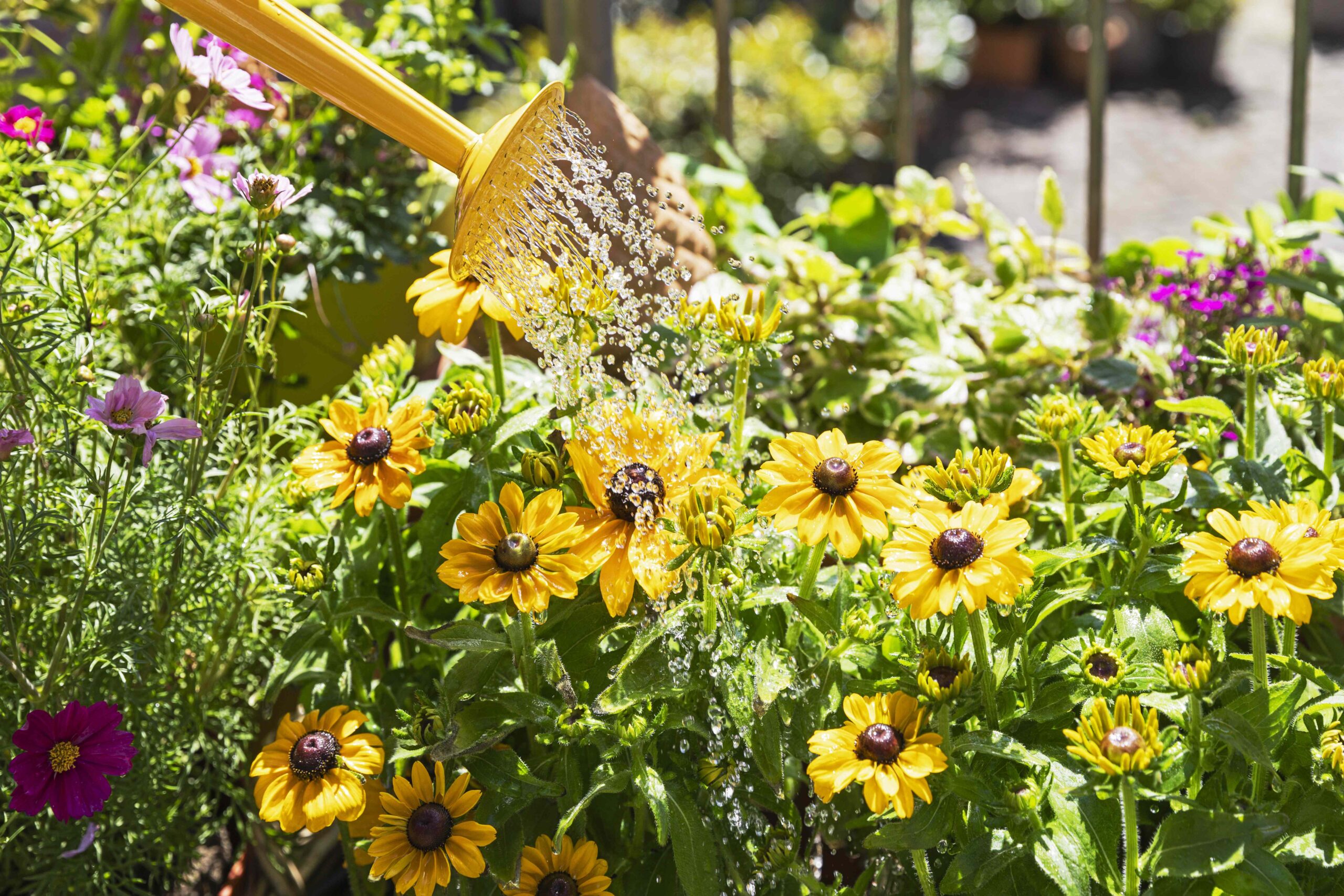Key Points
- Test the soil for moisture before watering wilted plants. Both too much and too little water can cause wilting during hot temperatures.
- Water in the morning or evening during cooler parts of the day. Water evaporates too quickly in hot temperatures.
- Water deeply when the top 2 to 3 inches of soil gets dry. Use drip irrigation or a low-pressure hose at soil level.
Maintaining outdoor plants and gardens can be a struggle when summer temperatures soar. But when your plants begin to look limp and wilted, it doesn’t always mean you need to water. In fact, overwatering could be the problem.
Achieving the right balance between soil moisture and air temperature during extreme heat is key to vibrant, healthy gardens.
Why Overwatering Happens in Summer
During periods of high temperatures, humans perspire to release body heat. Plants stay cool using a similar process called transpiration. Roots take up water, which the leaves release to cool the surrounding air. Waterlogged soil crowds out the oxygen plants need to transpire effectively—and when air temperatures continue to rise, the plants become overheated.
Overwatering stresses plants already struggling to survive high temperatures. It negatively affects water and nutrient uptake, stunts growth, and foliage yellows or wilts. Root rot can occur and lead to plant death. Excess moisture also invites fungal infections, insect pests, and crown rot.
It seems to make sense that a drooping plant needs water, but adding water is not always the right solution and could make the problem worse.
Want more gardening tips? Sign up for our free gardening newsletter for our best growing tips, troubleshooting hacks, and more!
10 Ways to Avoid Overwatering in Summer Heat
It’s not uncommon for plants to wilt in the afternoon summer sun. The top 2 to 3 inches of soil may feel dry, but moisture at depths of 6 to 8 inches allows most plants to transpire effectively. Here are 10 ways to avoid overwatering and help your plants survive summer heat.
- Water Deeply: Irrigating less frequently but for longer periods of time allows moisture to penetrate deeper into the root zone where it’s most needed.
- Water Early or Late: Water delivered in the afternoon heat evaporates too quickly for plants to use it effectively. Water during cooler periods in early morning or late evening for the best benefit.
- Drip Irrigation: Watering at soil level facilitates deep watering while reducing the potential for fungal disease, which tends to develop with overhead watering during periods of high temperatures.
- Test Moisture Before Watering: A moisture meter is a useful tool that reads how much water is in the soil and calculates how much is needed.
- Let Top Soil Dry Out: Allow the top 2 to 3 inches of soil to dry before watering deeply.
- Monitor Weather: Install a rain gauge and keep an eye on weather forecasts in your area. Knowledge of expected rainfall and amounts helps determine if and when to water.
- Mulch: Mulch supports plant vigor by cooling the soil and retaining moisture during extreme heat.
- Avoid Set Schedules: Turn off timers for irrigation systems and water on an ‘as needed’ basis.
- Understand Water Needs for Specific Plants: Bedding plants and garden vegetables often have similar water needs, but trees, shrubs, and other ornamentals may require a different amount. Avoid mistakes by understanding the moisture needs of different types of plants.
- Plant in Pots with Drainage Holes: When growing in containers, drainage holes are critical. Potted plants dry out more quickly but are as easily damaged by soggy soil as plants grown in the ground.
10 Signs Your Plants Are Overwatered
Watch for these 10 signs your soil is too wet and make corrections before it’s too late. Root rot and crown rot indicate irreversible disease has set in, usually resulting in plant loss.
- Loss of Vigor: Plant grows slowly or becomes stunted.
- Yellow or Brown Wilted Leaves: Leaves lose green color, curl, and wilt.
- Premature Leaf Drop: Plants drop normal-looking foliage.
- Drooping or Mushy Stems: Stems lean or droop.
- Water Spots and Blisters on Foliage: Brown sunken spots or raised water water-filled blisters appear on leaves.
- Pooling Water: Water fails to drain around the plant, or the soil surface stays consistently wet.
- Moldy Soil: White, gray, green, or black mold appears on the soil surface.
- Fungus Gnats: Fungus gnats infest plants.
- Root Rot: Roots turn mushy and brown or black.
- Crown Rot: Stems turn mushy at soil level, leaves drop, and the center of the plant turns brown or black and spongy.
How to Fix an Overwatered Plant
Overwatered container plants can be moved into sunnier locations or repotted with fresh soil. While this isn’t practical for most garden-grown plants, there are ways you can support recovery.
Start by allowing the soil to dry out completely to a depth of at least several inches. Work up the soil around the plant with a garden fork to oxygenate and improve drainage. Work in organic materials like compost and shredded leaves. Remove irreversibly damaged foliage. Allow time for the plant to recover before resuming irrigation. Then water deeply when the top 2 to 3 inches dry out.
If larger or more permanent plants, like shrubs or trees, suffer from continuously wet soil, consider adding drainage to direct water away from the plant.
FAQ
-
Avoid set schedules and, instead, check the top 2 to 3 inches of soil every few days. When it’s dry, water plants deeply. Moisture meters are useful, especially during high temperatures.
-
Water in the morning or evening and avoid the hottest parts of the day. Cooler periods help plants use water more efficiently.










